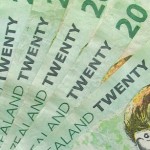Yesterday’s trade (in GMT terms) saw USD/CAD within the range of 1.3111-1.3217. The pair closed at 1.3192, edging up 0.55% compared to Mondays close. It has been the 183rd gain in the past 352 trading days and also the steepest one since September 23rd. The daily high has been a level unseen since September 28th, when a high of 1.3270 was registered. The major pair has gone up 0.49% so far during the current month, following a 0.18% gain in September.
At 8:29 GMT today USD/CAD was inching up 0.02% on the day to trade at 1.3194. The pair touched a daily high at 1.3204 during early Asian trade, overshooting the daily R1 level, and a daily low at 1.3165 during the mid phase of the Asian trading session.
On Wednesday USD/CAD trading may be influenced by the following macroeconomic reports and other events as listed below.
Fundamentals
United States
Change in employment by the ADP
Employers in the US non-farm private sector probably added 170 000 new jobs during September, according to the median estimate by experts, following 177 000 new positions added in August. If expectations were met, this would be the slowest employment growth since April, when the revised down 149 000 new jobs were reported.
In August, employment in the goods-producing sector dropped by 6 000, while employment in services increased by 183 000. Employment in trade, transportation and utilities grew by 26 000 during the month, in professional and business services – by 53 000 and in financial activities – by 15 000. On the other hand, employment in US construction fell by 2 000, while being unchanged in the manufacturing sector.
In case new job growth was slower than expected in September, this would have a moderate-to-strong bearish effect on the US dollar. The official figure is scheduled to be released at 12:15 GMT.
Balance of Trade
The deficit on US balance of trade probably widened to USD 40.00 billion in August, according to market expectations, from a deficit figure of USD 39.47 billion in July. The latter has been the lowest trade gap since April, as total exports expanded to their highest level since September 2015, while total imports shrank.
In July, US exports grew at a monthly rate of 1.9% to USD 186.3 billion, as goods exports rose by USD 3.4 billion to USD 124.1 billion and exports of services edged down less than USD 0.1 billion to USD 62.2 billion.
During the same month, US imports shrank at a monthly rate of 0.8% to USD 225.8 billion, as purchases of goods dropped by USD 1.9 billion to USD 184.4 billion and inbound shipments of services edged up USD 0.1 billion to USD 41.4 billion.
The year-to-date trade deficit narrowed 0.2% (USD 0.5 billion) compared to the same period a year ago.
In case the trade balance deficit widened more than anticipated in August, this would have a strong bearish effect on the US dollar, because of negative implications in regard to economic growth. The Bureau of Economic Analysis will release the official trade data at 12:30 GMT.
Fed speakers
At 13:30 GMT the Fed President for Minneapolis, Neel Kashkari, is expected to take a statement at the “Early Childhood Development in Indian Country” Conference, which will be hosted by the Federal Reserve Bank of Minneapolis.
Meanwhile, at 21:00 GMT the Fed President for Richmond and also a member of the Federal Open Market Committee, Jeffrey Lacker, is to speak on “Does Federal Reserve Governance Need Reform?” at Marshall University.
Any remarks in regard to the Bank’s future policy or US macroeconomic environment would heighten USD volatility.
Services PMI by Markit – final reading
The final Services Purchasing Managers’ Index probably confirmed the preliminary reading of 51.9 in September, according to market expectations. It has been the highest PMI reading since April, when a final 52.8 was reported. In August the index came in at a final 51.0, up from a preliminary reading of 50.9.
According to provisional data, in September, new business growth continued, while new orders, employment growth and input cost inflation slowed.
Values above the key level of 50.0 indicate optimism (expanding activity). In case services sector activity rose at a faster rate than anticipated in September, this would have a moderate bullish effect on the US dollar. The final data by Markit Economics is due out at 13:45 GMT.
ISM Non-Manufacturing PMI
Activity in United States’ sector of services probably increased at a faster pace in September from a month ago, with the corresponding non-manufacturing PMI coming in at a reading of 53.0, according to the median forecast by experts, up from a level of 51.4 in August. If expectations were met, September would be the 81st consecutive month, when the PMI stood in the area above 50.0.
August’s headline PMI reading has been the lowest since February 2010. The New Orders Index stood at 51.4 in August, sliding from a reading of 60.3 in the prior month. The Employment Index went down to 50.7 in August, after being at 51.4 in July, according to data by the Institute for Supply Management (ISM). The Prices Index edged down to 51.8 in August from 51.9 in July, which indicated prices went up for a fifth consecutive month, but yet, at a slower rate. The Non-Manufacturing Business Activity Index tumbled to 51.8 in August from a reading of 59.3 in July, indicating growth for an 85th straight month. Among a total of 18 non-manufacturing industries, 11 reported expansion and 7 reported contraction in general activity in August.
In case the Non-Manufacturing PMI accelerated more than anticipated in September, this would have a strong bullish effect on the US Dollar. The Institute for Supply Management (ISM) is to release the official reading at 14:00 GMT.
Canada
Balance of Trade
The deficit on Canadian balance of trade probably widened to CAD 2.60 billion in August, according to the median estimate by experts, following a deficit figure of CAD 2.49 billion in the preceding month. The latter has been the lowest trade gap since February.
In July, total exports rose 3.4% to reach CAD 42.7 billion. 9 out of 11 sections registered growth, with the largest contribution coming from shipments of motor vehicles and parts, metal and non-metallic mineral products, aircraft and other transportation equipment and parts, industrial machinery, equipment and parts.
Canada’s total imports dropped at a monthly rate of 0.1% to reach CAD 45.2 billion in July, with 6 out of 11 sections recording growth. The drop in purchases of consumer goods, motor vehicles and parts, and electronic and electrical equipment and parts was partially offset by the increase in purchases of metal ores and non-metallic minerals.
In annual terms, Canada’s exports shrank 7% in July, while imports fell 2.6%.
In case the trade balance deficit widened more than expected in August, this would have a strong bearish effect on the Canadian dollar, because of negative implications regarding economic growth. Statistics Canada will release the official trade report at 12:30 GMT.
Bond Yield Spread
The yield on Canada’s 2-year government bonds went up as high as 0.558% on October 4th, or the highest level since September 23rd (0.579%), after which it closed at 0.555% to add 1.6 basis points (0.016 percentage point) compared to October 3rd.
Meanwhile, the yield on US 2-year government bonds climbed as high as 0.834% on October 4th, or the highest level since September 21st (0.848%), after which it fell to 0.822% at the close to add 2.4 basis points (0.024 percentage point) compared to October 3rd.
The spread between 2-year US and 2-year Canadian bond yields, which reflects the flow of funds in a short term, widened to 0.267% on October 4th from 0.259% on October 3rd. The October 4th yield spread has been the largest one since June 5th, when the difference was 0.277%.
Daily, Weekly and Monthly Pivot Levels
By employing the Camarilla calculation method, the daily levels of importance for USD/CAD are presented as follows:
R1 – 1.3202
R2 – 1.3211
R3 (Range Resistance – Sell) – 1.3221
R4 (Long Breakout) – 1.3250
R5 (Breakout Target 1) – 1.3284
R6 (Breakout Target 2) – 1.3299
S1 – 1.3182
S2 – 1.3173
S3 (Range Support – Buy) – 1.3163
S4 (Short Breakout) – 1.3134
S5 (Breakout Target 1) – 1.3100
S6 (Breakout Target 2) – 1.3085
By using the traditional method of calculation, the weekly levels of importance for USD/CAD are presented as follows:
Central Pivot Point – 1.3152
R1 – 1.3257
R2 – 1.3385
R3 – 1.3490
R4 – 1.3594
S1 – 1.3024
S2 – 1.2919
S3 – 1.2791
S4 – 1.2662
In monthly terms, for USD/CAD we have the following pivots:
Central Pivot Point – 1.3077
R1 – 1.3332
R2 – 1.3535
R3 – 1.3790
R4 – 1.4044
S1 – 1.2874
S2 – 1.2619
S3 – 1.2416
S4 – 1.2212





